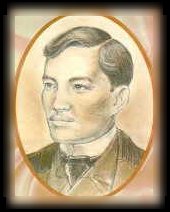Jose Rizal was born on June 19, 1861 in Calamba, Laguna to Don
Francisco Mercado Rizal and Doņa Teodora Alonso Realonda. Don
Francisco was a landholder and a leasee of the Dominican lands in
Calamba. He enrolled at the Ateneo de Manila with a degree in Bachelor
of Arts on March 14, 1877 with excellent grades. He enrolled at the
University of Santo Tomas to take up medicine but he found the student life
frustrating due to discriminations against the Filipinos and the method of
teaching uninspiring.
Without the knowledge of his parents, he secretly left for Spain. At the
Central University of Madrid, he enrolled in medicine and Philosophy and
Letters. He joined the Circulo Hispano Filipino, wrote for the La Solidaridad and gave orations to
fellow Filipinos whose genius and achievements were recognized by the European community. He
was also able to write and publish the Noli Me Tangere. After finishing his course, he went to various
European cities to specialize in Opthalmology. He got acquainted with various scientists and other
authorities in their fields of endeavors. He joined scientific organizations and mastered other
European languages. Noli Me Tangere was printed in Berlin and circulated in Europe but was
banned in the Philippines. On July 23, 1887, he sailed back to the Philippines. From Calamba, he
was summoned by the Governor General Emilio Terrero to Malacaņang due to the complaints of the
friars on the Noli Me Tangere. Due to their insistence, the Governor General advised Rizal to leave
the country.
Rizal left for Europe but passed Hongkong, Macau and Japan before crossing the Pacific Ocean to
the United States. He took a train to the US east coast via Chicago and the Niagara Falls to New
York where he sailed for England. In London, he came across Antonio Morgas Sucesos de las
Islas Filipinas, a book which related that Filipinos had a fairly well advanced state of civilization before
the Spaniards came. He also read works of early Spanish friars on the Philippines at the same time he
contributed articles for various magazines. He continued to study other European languages. While in
Belgium he had his second Novel, El Filibusterismo published. He also received the news of his
parents eviction from Calamba and the exile of some members of the family to the different places.
He went to Hongkong on advise of his parents where he lived briefly together with his family. He
decided to return to the Philippines.
A few days after his arrival, he was summoned to Malacaņang and on July 6, 1892, Governor
General Despujol had him arrested and deported to Dapitan where he stayed for four years. He
volunteered his services as a surgeon to Cuba where Spanish soldiers were fighting the Cuban
Revolutionaries. His request was granted but while on board he was placed on arrest and brought to
Barcelona for imprisonment. He was returned to Manila on November 3, 1896 and was imprisoned
in Fort Santiago where he was tried by a military court and was found guilty on the charges of
rebellion, sedition and illegal organization of societies.
He was meted death penalty. On December 30, 1896 he was shot in Bagumbayan Field



